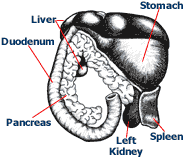| Pancreas: Anatomy & Function
Race Foster, DVM Marty Smith, DVM Drs. Foster & Smith, Inc. Anatomy
Hormonal or endocrine function (insulin and glucagon) The glucose-regulating hormones produced by the pancreas are insulin and glucagon. When starches and carbohydrates are eaten, they are broken down into the sugar glucose. The glucose is absorbed through the wall of the digestive tract and passes into the bloodstream. Insulin allows glucose to leave the bloodstream and enter the body's tissues. Glucose can then be utilized as energy for the cells. When glucose levels are high, glucagon causes it to be stored in the liver and muscles as glycogen. If not enough insulin is produced, diabetes mellitus (sugar diabetes) can occur. Digestive or exocrine function (trypsin, chymotrypsin and lipases) The pancreas produces the protein-digesting enzymes trypsin
and chymotrypsin. Fat digestion is aided by
Pancreatitis (Inflammation)
The pancreas is a V-shaped organ located behind the stomach and
the first section of the
Causes Multiple factors can contribute to the development of pancreatitis. Certain medications, infections; metabolic disorders including hyperlipidemia (high amounts of lipid in the blood) and hypercalcemia (high amounts of calcium in the blood); and trauma and shock can be associated with the development of pancreatitis. Middle-aged dogs appear to be at increased risk of developing pancreatitis; as a breed, Schnauzers and Yorkshire terriers appear to be more prone to pancreatitis. Nutrition also plays a role. Dogs with diets high in fat, or dogs who 'steal' or are fed greasy 'people food' seem to have a high incidence of the disease. Symptoms Common symptoms of the acute form of pancreatitis in dogs include a very painful abdomen, abdominal distention, lack of appetite, depression, dehydration, a 'hunched up' posture, vomiting, diarrhea and yellow, greasy stool. Fever often accompanies these symptoms. Animals with more severe disease can develop heart arrhythmias, sepsis (body-wide infection), difficulty breathing, and a life-threatening condition called disseminated intravascular coagulation (DIC) which results in multiple hemorrhages. If the inflammation is severe, organs surrounding the pancreas could be 'autodigested' by pancreatic enzymes released from the damaged pancreas and become permanently damaged. Diagnosis The diagnosis of pancreatitis is made through information obtained from
the history,
Treatment The goal of treatment is to rest the pancreas, provide supportive care
and control complications.
The second major component of treatment is fluid therapy. Dehydration
and electrolyte
Dogs who are experiencing severe pain can be treated with pain relievers
such as meperidine
If the pancreatitis was caused by a medication, the medication should
be stopped. If is was
In rare instances where there are intestinal complications or the development
of
Long term management and prognosis Pancreatitis can be a very unpredictable disease. In most cases, if
the pancreatitis was mild and
Dogs with severe pancreatitis can recover, but may also develop fatal complications. The risk of developing fatal pancreatitis is increased in dogs who are overweight, or have diabetes mellitus, hyperadrenocorticism, hypothyroidism, gastrointestinal tract disease, and epilepsy. Pets who have repeated bouts of pancreatitis may need to be fed low-fat diets to prevent recurrence. Even so, some animals develop chronic pancreatitis which can lead to diabetes mellitus and/or pancreatic insufficiency, also called 'maldigestion syndrome'. In pancreatic insufficiency, the nutrients in food are passed out in
the feces undigested. An
Summary Acute pancreatitis can be a life-threatening condition, and early recognition
and treatment can improve chances of recovery. In dogs, fever, lack of
appetite, depression and vomiting are the most common signs. Treatment
is based upon stopping all oral intake to rest the pancreas, correcting
the dehydration and maintaining proper fluid and electrolyte balances,
and treating any complications or underlying conditions.
References
Hess, RS; Kass, PH; Shofer, FS; Van Winkle, TJ; Washabau, RJ. Evaluation of risk factors for fatal acute pancreatitis in dogs. Journal of the American Veterinary Association. 1999;214(1):46-51. Stewart, AF. Pancreatitis in dogs and cats: Cause, pathogenesis, diagnosis and treatment. The Compendium on Continuing Education for the Practicing Veterinarian. 1994;16(11):1423-1431. Williams, DA. Exocrine pancreatic disease.In Ettinger, SJ; Feldman EC
(eds): Textbook of Veterinary Internal Medicine. WB Saunders Co. Philadelphia,
PA; 2000;1347-1355.
These articles can be found at www.peteducation.com
© 2001 Drs. Foster & Smith, Inc.
|


